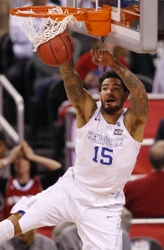Willie Cauley-Stein brings some clarity to a process normally based upon on projections and expectations, at least on one end of the basketball court. There’s no dispute or concern about Cauley-Stein’s ability to be a defensive impact player in the NBA. He’s got all the tools and physical gifts to become one of the league’s premier defenders. That’s why the 7-footer is ranked as the No. 2 center in the draft behind Duke’s Jahlil Okafor and a virtual lock to be selected in the Top 10. He’s currently rated No. 8 on Chad Ford’s ESPN Insider Big Board, while Jonathan Givony’s DraftExpress slots him at No. 6 overall.
The University of Kentucky product can not only defend other big men, he can handle wing players because of his quickness and length. He’s also one of the very few big men who can switch out on a point guard without that situation being an obvious mismatch. With most NBA teams relying heavily on pick-and-rolls to create space and quality looks, Cauley-Stein can switch, hedge and recover on those plays with aplomb, which will often force the offense to take low-percentage shots with the shot clock winding down.
He can also create turnovers and provide rim protection. He led the Wildcats in steals in both his sophomore and junior seasons and recorded 106 blocks during his sophomore campaign. That figure dropped to 67 last season, partially due to Kentucky’s ability to seal off the paint and also because Cauley-Stein had another shotblocker, Karl Anthony-Towns, patrolling the lane alongside him. With his long arms and ability to cover so much ground, Cauley-Stein should have no trouble altering and blocking shots in situations where he’s a help defender. Add up those attributes and it’s no wonder he’s already being compared to the likes of DeAndre Jordan, Tyson Chandler and Andre Drummond as a defensive force.
If there are any issues regarding Cauley-Stein defensively, it would be his frame and defensive rebounding. His needs to get stronger to compete physically with other post players on a nightly basis, though that can be said for virtually any big man entering the NBA. A slightly bigger concern is whether Cauley-Stein truly likes to mix it up underneath. As Givony points out, he can be outworked in the paint at times and he doesn’t consistently establish good box-out position. That explains why his defensive rebounding rate was a relatively modest 6.6 per 40 minutes in college.
There were no surprises regarding Cauley-Stein’s physical attributes at the draft combine. He measured a tad over 6’11” without shoes and 7’0” wearing them. His wingspan was an impressive 7’3” and he came to Chicago in excellent condition with a body fat content of 6.3%.
If Cauley-Stein had any semblance of an offensive game, he could have been the top pick in the draft. But that’s where the uncertainty regarding Cauley-Stein kicks in. The word raw is frequently mentioned by draft experts, scouts and front-office personnel when the subject of his offensive game is brought up. His contributions on that end mainly consist of dunks and layups created by guard penetration, offensive rebounds and transition opportunities. He averaged 8.9 points last season in the Wildcats’ balanced attack.
Kentucky didn’t look for Cauley-Stein to score on postups and midrange shots. As a result, he failed to develop any signature moves or carve out any sweet spots where defenders had to respect him. He made just one-third of his two-point jump shots in his junior year.
Without getting frequent touches, Cauley-Stein has not developed a knack for passing out of the post or finding open shooters and cutters. He averaged less than one assist per game during his three college seasons.
One area where he did show steady improvement was his free throw shooting. He went from a brutal 37.2% as a freshman to 48.2% the next year to 61.7% last season. Even if he only improves marginally as a foul shooter as a pro, that will be good enough to discourage opponents from intentionally fouling him.
Another knock against Cauley-Stein is his motor. He has often been criticized for looking disinterested at times and taking plays off, though he played with more intensity as his college career unfolded. The lack of focus at times has many scouts wondering if Cauley-Stein has a love for the game.
As an unnamed GM told NBA.com’s Scott Howard-Cooper, Cauley-Stein “leaves you wanting. You see the talent there, but you always think that there’s more he can give.”
Cauley-Stein has a difficult time understanding what all the fuss on this issue.
“If I didn’t love it, I wouldn’t put my body on the line, I wouldn’t run the way I do, I wouldn’t jump the way I do,” he told Scott-Cooper. “I’d be scared to do those things if I didn’t love the game. It just doesn’t make sense to me the way I play that I don’t love the game.”
There’s enough love over Cauley-Stein’s defensive prowess to quell most of the concerns about his shortcomings, perceived or otherwise. He should have a long NBA career, even if he settles for simply being a defensive stopper. Depending on team needs and draft-day trades, Cauley-Stein could even wind up moving into the top five. That’s the value of offering clarity in a sea of uncertainty.
